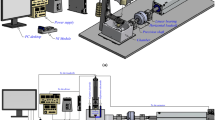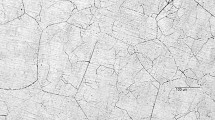Abstract
Tribocorrosion covers the science of surface transformations resulting from the interaction of mechanical loading and chemical reactions that occur between elements of a tribosystem exposed to corrosive environments. Implant materials are subjected to relative movements, which can cause wear damage, together with corrosive attack of the body fluids. Ti–6Al–4V alloy has been widely used for this purpose due to its superior biocompatibility and excellent corrosion resistance and good mechanical properties. The purpose of this work is to evaluate the tribocorrosion of Ti–6Al–4V alloy under different load and surface conditions. The tribocorrosion tests of Ti–6Al–4V alloy were performed using pin on disc tests at phosphate buffer saline solution (PBS), under various loading (0.5–25) N and surfaces roughness (240, 320, 400, 600) μm grits. Surface morphology, chemical composition and tribocorrosion resistance studied by scanning electron microscopy (SEM), energy-dispersive spectroscopy (EDS) and Tafel potential polarization. The result indicate, by increasing contact load, the smoother surface (600 μm grit) give lower average tribocorrosion current density as compared with surface (320, 240, 400) μm grits suggesting that the damage is more pronounced on the smooth surface.











Similar content being viewed by others
References
Liu W, Liu S, Wang L (2019) Surface modification of biomedical titanium alloy: micromorphology, microstructure evolution and biomedical applications. Coatings 249:1–23
Elias C, Lima J, Valiev R, Meyers M (2008) Biomedical applications of titanium and its alloys. Biol Mater Sci 60:46–49
Yazdi R, Ghasemi H, Abedini M, Wang C, Neville A (2018) Mechanism of tribofilm formation on Ti–6Al–4V oxygen diffusion layer in a simulated body fluid. J Mech Behav Biomed Mater 77:660–670
Li DG, Wang JD, Chen DR, Liang P (2015) Influence of molybdenum on tribo-corrosion behavior of 316L stainless steel in artificial saliva. J Bio and Tribo-Corros 2:1–14
Prando D, Brenna A, Vittroria M, Diamanti S, Beratta F, Bolzoni M Ormellease, Pia Pedeferri M (2017) Corrosion of titanium: part 1: aggressive environments and main forms of degradation. J Appl Biomater Funct Mater 15(4):291–302
Park J, Lakes R (2007) Biomaterials: an introduction. Springer Science & Business Media, Berlin
Lepicka M, Gradzka-Dahlke M (2016) Surface modification of Ti6Al4 V titanium alloy for biomedical applications and its effect on tribological performance—a review. Rev Adv Mater Sci 46(1):86–103
Yazdi R, Ghasemia H, Wangb C, Neville A (2017) Bio-corrosion behaviour of oxygen diffusion layer on Ti-6Al-4 V during tribocorrosion. Corros Sci 128:23–32
Gao A, Hang R, Bai L, Tang B, Chu PK (2018) Electrochemical surface engineering of titanium-based alloys for biomedical application. Electrochim Acta 271:699–718
Bailey R (2018) Tribocorrosion response of surface-modified Ti in a 0.9% NaCl solution. Lubricants 6(4):86
Huang W, Wang Z, Liu C, Yu Y (2015) Wear and electrochemical corrosion behavior of biomedical Ti–25Nb–3Mo–3Zr–2Sn alloy in simulated physiological solutions. J Bio Tribo-Corros 1(1):1–10
Licausi M, Munoz A, Borras V, Espallargas N (2015) Tribocorrosion mechanisms of Ti6Al4 V in artificial saliva by zero-resistance ammetry (ZRA) technique. J Bio Tribo-Corros 1(8):1–11
Chauhan S, Dass K (2013) Dry sliding wear behaviour of titanium (Grade 5) alloy by using response surface methodology. Adv Tribol 2013:1–9
Pejakovic V, Totolin V, Rodriguez Ripoll M (2018) Tribocorrosion behaviour of Ti6Al4 V in artificial seawater at low contact pressures. Tribol Int 119:55–65
Dimah M, Albeza D, Borras A (2012) Study of the biotribocorrosion behaviour of titanium biomedical alloys in simulated body fluids by electrochemical techniques. Wear 294:409–418
Licausi M, Igual A, Amig V (2013) Tribocorrosion mechanisms of Ti6Al4 V biomedical alloys in artificial saliva with different pHs. J Phys D 46:40
Mischler S (2008) Triboelectrochemical techniques and interpretation methods in tribocorrosion: a comparative evaluation. Tribol Int 41(7):573–583
Landolt D, Mischler S, Stemp M (2001) Electrochemical methods in tribocorrosion: a critical appraisal. Electrochim Acta 46:3913–3929
Mathew M, Srinivasa P, Pourzal R, Fischer A, Wimmer M (2009) Significance of tribocorrosion in biomedical applications: overview and current status. Adv Tribol 2009:1–12
Mathew M, Ariza E, Rocha L, Fernandes A, Vaz F (2008) TiCxOy thin films for decorative applications: tribocorrosion mechanisms and synergism. Tribol Int 41(7):603–615
Jamaati R, Reza M, Jerzy A, Duan L (2011) Tribocorrosion behavior of aluminium/alumina composite manufactured by anodizing and ARB processes. J Mater Eng Perform 20(9):1600–1605
Bryant M, Neville A (2017) Fretting corrosion of CoCr alloy: effect of load and displacement on the degradation mechanisms. Proc Inst Mech Eng [H] 231(2):114–126
Lopez-Ortega A, Arana J, Bayon R (2018) Tribocorrosion of passive materials: a review on test procedures and standards. Int J Corros 2018:1–24
Bailey R, Sun Y (2015) Corrosion and tribocorrosion performance of thermally oxidized commercially pure titanium in a 0.9% NaCl solution. J Mater Eng Perform 24(4):1669–1678
Mischler S, Barril S, Landolt D (2009) Fretting corrosion behaviour of Ti6Al4 V/PMMA contact in simulated body fluid. Tribol-Mater Surf Interfaces 3(1):16–23
Author information
Authors and Affiliations
Corresponding author
Additional information
Publisher's Note
Springer Nature remains neutral with regard to jurisdictional claims in published maps and institutional affiliations.
Rights and permissions
About this article
Cite this article
Hammood, A.S., Thair, L., Altawaly, H.D. et al. Tribocorrosion Behaviour of Ti–6Al–4V Alloy in Biomedical Implants: Effects of Applied Load and Surface Roughness on Material Degradation. J Bio Tribo Corros 5, 85 (2019). https://doi.org/10.1007/s40735-019-0277-x
Received:
Revised:
Accepted:
Published:
DOI: https://doi.org/10.1007/s40735-019-0277-x




